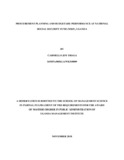| dc.description.abstract | This study focused on procurement planning and budgetary performance at National Social
Security Fund (NSSF). The study specifically examined the effect of budgeting procedures on
budget performance at NSSF, the effect of needs assessment on budget performance at NSSF
and the effect of procurement cost estimation on performance of NSSF. The study used cross
sectional survey research design with both qualitative and quantitative approaches. The study
population involved the Heads of Departments, Managers, Procurement Champions, User
Departments, Officers and other staff based in Headquarters. Data collection utilized
questionnaires and interviews. Data analyzed to obtain frequencies, mean, standard deviation,
correlations and regression statistics to ascertain the significance of the variables. In the study, it
was revealed that there is a positive significant relationship between procurement cost estimation
and budgetary performance and this was in line with the Pearson’s correlation coefficients,
which presented a positive relationship. This was also supported by the descriptive statistics
findings of mean and standard deviation, which showed that there is a relationship between the
two variables. These findings are in agreement with previous scholars such as Jasko et al., (2017)
who analyzed the cost efficiency of the public procurement process at the local level concluded
that there is a positive relationship between cost estimation and perf
These findings show the importance of estimating costs and past scholars such as Yakovlev et al.
(2010) who highlighted the importance of procurement costs estimation, using a large public
entity as an example. The costs of administering public procurement, according to the estimates,
accounted for 0.6% of the total volume of contracts. These costs were borne by the public entity
in all cases, even if competitive procedures did not produce any savings from price reduction.
Although Costantino et al. (2012) address the problem of measuring additional costs of
purchasing; they focus mostly on measuring the costs associated with a larger number of
procurement bidders, comparing these costs with possible benefits.
The researcher recommends that monitoring should be seriously being enforced at NSSF to
ensure that all budgets are absorbed for the purpose they were set.
He further recommends that effective needs assessment should continuously be implemented
before procurements are initiated to avoid wastage and corruption at NSSF since the findings
showed that it is the most important element of procurement planning and the interviews
revealed that most procurement is implemented without proper needs assessment.
It is recommended that in order for budgetary performance to improve at NSSF, the user
departments at NSSF should continuously carry out a clear market survey in order to ascertain
the market values of the items and make accurate estimates before carrying out the actual
procurement since it has been revealed by the findings that it is a very crucial element of
procurement planning | en_US |

